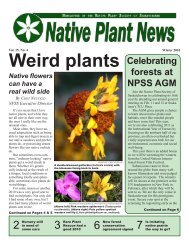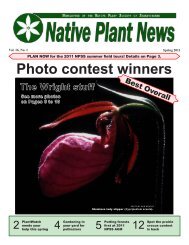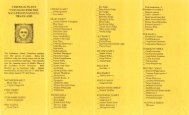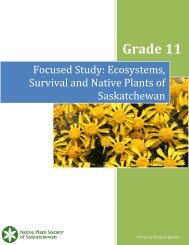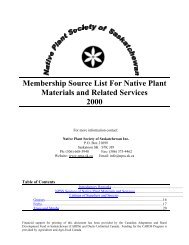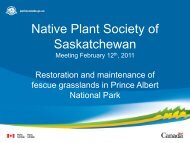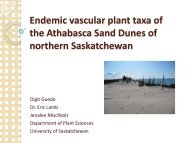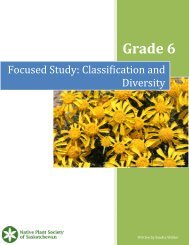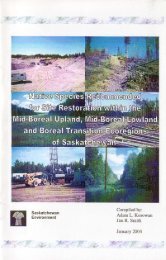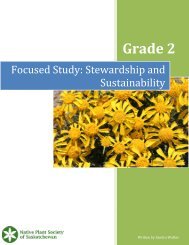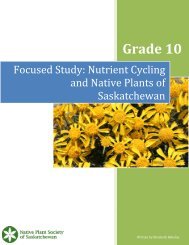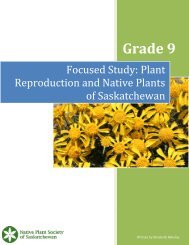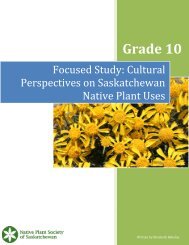Summer 2011 - Native Plant Society of Saskatchewan
Summer 2011 - Native Plant Society of Saskatchewan
Summer 2011 - Native Plant Society of Saskatchewan
You also want an ePaper? Increase the reach of your titles
YUMPU automatically turns print PDFs into web optimized ePapers that Google loves.
Vol. 16, No. 2<br />
<strong>Summer</strong> <strong>2011</strong><br />
Biodiversity on display<br />
NPSS goes on a <strong>Saskatchewan</strong> ecosystem bio blitz<br />
PHOTOS BY CHET NEUFELD<br />
(Above) Round-leaved orchid<br />
(Amerorchis rotundifolia) and<br />
(below) bogbean (Menyanthes<br />
trifoliata) in Prince Albert<br />
National Park. See story on<br />
Pages 6 and 7.<br />
PHOTO BY CHET NEUFELD<br />
(Above) Short-horned lizard (Phrynosoma hernandesi) basks in<br />
the sun at Grasslands National Park. See story on Page 3.<br />
PHOTOS BY DAVID FREEMAN<br />
(Above) Ground plum (Astragalus crassicarpus) grow<br />
at the Last Mountain Lake Wildlife Area Seed<br />
Nursery. (Right) A mealy primrose (Primula incana)<br />
stands at attention. See story on Pages 4 and 5.<br />
2<br />
Executive<br />
Director’s<br />
summer report<br />
5<br />
Celebrate our<br />
7<br />
History and<br />
8<br />
forests in <strong>2011</strong><br />
biodiversity at<br />
with a free tree<br />
the NE swale<br />
Photo contest<br />
is back for a<br />
third year<br />
1
NPSS Board<br />
President:<br />
Tara Sample 777-9137<br />
Past-President<br />
Michael Champion 780-6850<br />
Vice-President:<br />
John Hauer 463-5507<br />
Treasurer:<br />
Cheri Sykes 924-8028<br />
Secretary:<br />
Sarah James 780-6121<br />
Directors:<br />
Leanne Heisler 347-0447 ext. 225<br />
Jennifer Lohmeyer 787-8707<br />
Margaret Put 921-6361<br />
Kerry Hecker 836-2022<br />
Shelley Heidinger 634-9771<br />
David Engel 472-5988<br />
Executive Director:<br />
Chet Neufeld 668-3940<br />
Newsletter Editor:<br />
David Freeman 791-0047<br />
<strong>of</strong> Directors<br />
NPSS Address:<br />
<strong>Native</strong> <strong>Plant</strong> <strong>Society</strong> <strong>of</strong> <strong>Saskatchewan</strong><br />
P.O. Box 21099, Saskatoon, SK S7H 5N9<br />
Phone: (306) 668-3940 Fax: (306) 668-3940<br />
E-mail: info@npss.sk.ca Website: www.npss.sk.ca<br />
<strong>Native</strong> <strong>Plant</strong> News is a quarterly publication <strong>of</strong> the <strong>Native</strong> <strong>Plant</strong><br />
<strong>Society</strong> <strong>of</strong> <strong>Saskatchewan</strong> (NPSS) and is one <strong>of</strong> the benefits <strong>of</strong><br />
membership. Members are invited to submit articles, news,<br />
views, photographs and comments. Views expressed by the<br />
authors are not necessarily those <strong>of</strong> the NPSS.<br />
Deadlines: Submission Publication<br />
Winter Issue: November 1 December 15<br />
Spring Issue: February 1 March 15<br />
<strong>Summer</strong> Issue: May 1 June 15<br />
Fall Issue: August 1 September 15<br />
Membership Dues (Year End November 30 th )<br />
Individual $30<br />
Family $45<br />
Student $15<br />
Corporate $200<br />
Life $500<br />
Please contact the NPSS <strong>of</strong>fice for information about the<br />
lifetime membership instalment payment option.<br />
2<br />
Executive director’s<br />
summer message<br />
It’s hard to believe the summer is half over considering the<br />
months <strong>of</strong> rain we received already this year. We had more<br />
<strong>of</strong> a monsoon season than a spring. Despite all <strong>of</strong> the weather<br />
related problems, the NPSS has been as busy as ever.<br />
Our annual general meeting was one <strong>of</strong> the best attended<br />
in recent memory and we have had more field tours this<br />
summer than in a long time – this issue is dedicated to them<br />
almost entirely (see Pages 3 to 7 for more details).<br />
This year, we have also submitted many proposals for<br />
funding.<br />
Our proposal to once again control<br />
the invasive flowering rush was given<br />
provincial funding. With this support<br />
we hope to eradicate what remains <strong>of</strong><br />
the only known population <strong>of</strong> flowering<br />
rush in <strong>Saskatchewan</strong>, which will<br />
benefit wetland biodiversity across<br />
the province. We have also submitted<br />
two proposals with Environment Canada;<br />
one targeting invasive species<br />
through a combination <strong>of</strong> awareness<br />
campaigns and field projects and the<br />
other aimed at developing educational<br />
resources about native plants for <strong>Saskatchewan</strong> schools.<br />
Once again this year we were able to employ a summer<br />
student to tend our native plant nursery in Regina, but with<br />
reduced funding from previous years. Due to the rain, it has<br />
been a struggle to keep the weeds in check as it is difficult<br />
to access the site and equipment such as rototillers have so<br />
far not been an option. To try and get ahead <strong>of</strong> the weeds,<br />
we will once again be holding weeding bees at the nursery<br />
throughout the summer. A schedule is being drafted and will<br />
be sent out to the membership and posted on our website<br />
once it is finalized.<br />
Speaking <strong>of</strong> our website, if you haven’t visited it lately<br />
you’re missing out! We work hard to constantly keep it up to<br />
date with the latest event notices, projects and information.<br />
We have recently converted some <strong>of</strong> our print only resources<br />
to downloadable PDFs and have done the same with some<br />
<strong>of</strong> our native plant resources, like plant checklists for areas<br />
across <strong>Saskatchewan</strong>. You can find these under the Info<br />
Resources tab.<br />
In addition to using our website, why don’t you friend us<br />
on Facebook? We have an active pr<strong>of</strong>ile and are constantly<br />
updating it with new event notices, photos and videos. In<br />
fact, we have photos from our recent field tours posted there<br />
for your enjoyment.<br />
Speaking <strong>of</strong> Facebook, we’re currently part <strong>of</strong> an environmental<br />
contest sponsored by Evergreen and Fido called the<br />
Share Your Care Campaign. The groups with the most votes<br />
get funding, so we need you to vote for the NPSS project,<br />
<strong>Native</strong> <strong>Plant</strong>s in the Classroom. A link can be found our our<br />
Facebook page. Voting ends Aug. 14.<br />
Well that’s my update for this issue. If you have any questions<br />
about the society or any <strong>of</strong> our initiatives, please feel free<br />
to call me at 306-668-3940 or email me at info@npss.sk.ca.
GNP rare plant survey<br />
By Chet Neufeld<br />
NPSS Executive Director<br />
In early June the NPSS ventured to<br />
Grasslands National Park to conduct a<br />
rare plant survey at the bequest <strong>of</strong> park<br />
staff. Our members did not disappoint.<br />
The survey was conducted because<br />
Parks Canada is proposing to develop<br />
hiking trails in the Eagle Butte and 70<br />
Mile Butte area and needed experienced<br />
eyes to tell them if their proposed trail<br />
routes were going to impact any rare<br />
plant populations.<br />
On June 10 and 11, we had 10<br />
participants walk the proposed trails<br />
and map any rare plant populations they<br />
encountered. Due to the wet spring, the<br />
area was covered in blooming wildflowers,<br />
so it was difficult to concentrate on<br />
the task at hand with so much to see!<br />
Nonetheless, we managed to finish our<br />
survey by the end <strong>of</strong> the second day.<br />
What we found was amazing! Nearly<br />
every portion <strong>of</strong> the trail contained some<br />
rare plant species <strong>of</strong> interest (S3 and S4),<br />
and many were quite rare (S1 and S2).<br />
In fact, once we downloaded our GPS<br />
data, the rare plant occurrences basically<br />
joined one another to form the proposed<br />
trail route. Some <strong>of</strong> the very rare plant<br />
species included Indian milkvetch<br />
(Astragalus australis – an S2), clustered<br />
oreocarya (Cryptanthe celosioides – an<br />
S1), squirreltail (Elymus elymoides – an<br />
S2), Bessey’s locoweed (Oxytropis<br />
besseyi – an S2) and rush pink (Stephanomeria<br />
runcinata – an S1S2).<br />
In addition to the many colourful<br />
and interesting plants, we also<br />
PHOTO BY CHET NEUFELD<br />
Gumbo evening primrose (Oenothera caespitosa) showing<br />
its true colours. On the left is a newly bloomed flower in a<br />
pristine white, while on the right the older bloom is pink.<br />
PHOTO BY CHET NEUFELD<br />
NPSS members record rare plant<br />
populations in Grasslands National Park<br />
during the rare plant survey in June.<br />
spotted a large bull snake and two<br />
short-horned lizards – a very rare<br />
sight indeed. We also compiled a<br />
comprehensive plant species list for<br />
the proposed trail route, which was<br />
submitted to the park staff along with<br />
our rare plant map and report in order<br />
to help them with<br />
their management <strong>of</strong><br />
the site. Thank-you<br />
to Parks Canada and<br />
all who participated.<br />
Special thanks to<br />
Glen and Maureen<br />
Lee, Tracy Hansen<br />
and Candace Neufeld<br />
for their expertise.<br />
To view this<br />
checklist, visit our<br />
website under the<br />
News tab. To see<br />
more photos from the<br />
field trip, please visit<br />
our Facebook page.<br />
3<br />
Upcoming<br />
Events<br />
August <strong>2011</strong><br />
NPSS Regina Plain <strong>Native</strong> Prairie<br />
Seed Nursery Work Bee<br />
Saturday, August 13<br />
9 a.m. to noon<br />
Regina Plain <strong>Native</strong> Prairie Seed<br />
Nursery<br />
Regina, Sask.<br />
The nursery needs your help. Come<br />
on out to help rid the nursery <strong>of</strong> pesky<br />
weeds, conduct general maintenance and<br />
meet other native plant enthusiasts.<br />
www.npss.sk.ca<br />
September <strong>2011</strong><br />
<strong>Saskatchewan</strong> Wildlife Federation’s<br />
Women’s Outdoor Weekend<br />
September 10 and 11<br />
Lumsden Beach Camp<br />
Regina, Sask.<br />
Deadline to register is Friday, Aug. 19.<br />
Come out and learn outdoor skills such as<br />
canoeing, wildlife and birdsong identification,<br />
archery and much more! The Iron<br />
Chef food challenge will once again take<br />
place with this year’s mystery ingredient!<br />
Contact JeanAnne Prysliak by phone<br />
at 306-692-8812 or email at<br />
jprysliak.swf@sasktel.net<br />
www.swf.sk.ca<br />
19th Annual North American Weed<br />
Management Conference<br />
September 19 to 22<br />
Fort Garry Canad Inn,<br />
Winnipeg, Man.<br />
The NAWMA Conference will deliver<br />
a forum <strong>of</strong> national and international<br />
speakers covering a variety <strong>of</strong> topics related<br />
to weed control as well as hosting<br />
field tours, displays and social events.<br />
www.nawma.org/<br />
February <strong>2011</strong><br />
<strong>Native</strong> Praire Restoration/Reclamation<br />
Workshop 2012<br />
February 8 and 9, <strong>2011</strong><br />
TCU Place<br />
Saskatoon, Sask.<br />
Details to come.<br />
www.pcap-sk.org<br />
To submit your native plant<br />
related event to our events<br />
list, send your information<br />
(including date, contact,<br />
phone number and location)<br />
to info@npss.sk.ca.
PHOTOS BY DAVID FREEMAN<br />
(Left) Tour participants learn about native grasses in the seed nursery. (Right) Cotton-grass (Eriophorum sp.) in a riparian area.<br />
Restoring our prairie grasslands<br />
By Tara Sample<br />
NPSS President<br />
I have to admit that I was pretty<br />
excited about visiting the Last Mountain<br />
Lake National Wildlife Area this past<br />
June. As a student, I remember listening<br />
intently to a guest lecturer describe<br />
a new, large scale project to restore<br />
cultivated land in this area back to its<br />
former native self.<br />
That was over a decade ago, when<br />
restoration was a relatively new concept<br />
in <strong>Saskatchewan</strong>.<br />
I certainly wasn’t alone in my interest<br />
in the area. A good sized group <strong>of</strong> native<br />
plant enthusiasts gathered at the beautiful<br />
native plant nursery just outside the Last<br />
Mountain Lake National Wildlife Area<br />
(LMLNWA) <strong>of</strong>fice on June 25.<br />
PHOTO BY DAVID FREEMAN<br />
A Canadian toad (Bufo hemiophrys) hangs<br />
out in some buffalo grass.<br />
PHOTOS BY DAVID FREEMAN<br />
Female (right) and male (left) inflorescences <strong>of</strong> buffalo grass (Buchloe dactyloides).<br />
While the primary purpose <strong>of</strong> the<br />
nursery is to provide some <strong>of</strong> the seed<br />
used in restoration projects, the beds<br />
also provide visitors with a unique opportunity<br />
to familiarize themselves with<br />
70 plant species native to the area.<br />
Participants were able to see a variety<br />
<strong>of</strong> native plants in varying stages <strong>of</strong><br />
their reproduction cycle and learn about<br />
their propogation at the nursery from<br />
NPSS board member and Wildlife Area<br />
Manager, Kerry Hecker.<br />
The next stop was one <strong>of</strong> the patches<br />
<strong>of</strong> native mixed-grass prairie found<br />
within the LMLNWA. The area had been<br />
recently burned by Environment Canada.<br />
Fire is an important process that helps<br />
shaped the prairie ecozone. Fire has been<br />
re-introduced as a tool to maintain and<br />
improve the health <strong>of</strong> the prairie.<br />
4<br />
After seeing<br />
what native prairie<br />
looked like, the<br />
tour moved on to<br />
a restoration area<br />
that had once been<br />
farm land. Viewing<br />
it from the access<br />
road, it wasn’t what<br />
I had envisioned<br />
since my days as a<br />
student. It was not<br />
noticeably native,<br />
however, just a few<br />
steps in and the<br />
diversity became<br />
apparent.<br />
One after an-<br />
Continued on Page 5<br />
PHOTO BY DAVID FREEMAN<br />
Shootingstar<br />
(Dodecatheon<br />
conjugens)
Celebrate our<br />
forests with<br />
a free tree<br />
PHOTO BY DAVID FREEMAN<br />
A tour participant inspects a native plant in the Last<br />
Mountain Lake National Wildlife Area.<br />
Continued from Page 4<br />
other, the plants that we saw at the nursery were spotted,<br />
along with a few additional native species.<br />
While watching a butterfly flitter from one blanket<br />
flower to the next in a sea <strong>of</strong> native grasses and alfalfa,<br />
I couldn’t help but think that the measure <strong>of</strong> restoration<br />
success is somewhat dependant on where you’ve been and<br />
where you’re going.<br />
Sure, this isn’t the healthy native grassland we had just<br />
left, but it wasn’t the broken land it once was either.<br />
If you’ve never been to the Last Mountain Lake<br />
National Wildlife Area, it’s truly worth a visit.<br />
To commemorate<br />
<strong>2011</strong> as the International<br />
Year <strong>of</strong> Forests, the<br />
NPSS and the SaskPower<br />
Shand Greenhouse<br />
are giving away free<br />
tree and shrub seedlings<br />
to members.<br />
The NPSS currently<br />
has 250 <strong>of</strong> each <strong>of</strong> the<br />
following: red osier<br />
dogwood, trembling aspen,<br />
plains cottonwood<br />
and paper<br />
birch.<br />
You are<br />
welcome<br />
to as<br />
many as<br />
you want,<br />
subject to availability.<br />
Each seedling is<br />
approximately 1 foot<br />
tall with a soil plug<br />
about 6 to 8 inches long<br />
that comes in a plastic<br />
sleeve. The seedlings<br />
should be planted as<br />
soon as possible. Growing<br />
instructions are included.<br />
To request your seedlings, please email Chet Neufeld at<br />
info@npss.sk.ca with your name, address and the number<br />
and type <strong>of</strong> seedlings you want, or call Chet at 306-668-<br />
3940.<br />
Junegrass (Koeleria macrantha)<br />
PHOTO BY DAVID FREEMAN<br />
5
Exploring the plants<br />
<strong>of</strong> the boreal forest<br />
By Chet Neufeld<br />
NPSS Executive Director<br />
As a way to celebrate <strong>2011</strong> as the International<br />
Year <strong>of</strong> Forests, the NPSS held<br />
a field tour in the boreal forest <strong>of</strong> Prince<br />
Albert National Park on June 18 and 19.<br />
And the majesty <strong>of</strong> one <strong>of</strong> the province’s<br />
prettiest areas didn’t disappoint.<br />
The tour began with a visit to the<br />
Stony Meadow Plain in the fescue grasslands<br />
located along the Sturgeon River<br />
in the southwest corner <strong>of</strong> the park<br />
lead by Parks Canada employee Dusty<br />
Guedo. This area is rarely visited, so it<br />
was a real treat for participants to experience<br />
this unique area and the plants<br />
and animals that call it home. While we<br />
didn’t see any <strong>of</strong> the bison herds or wolf<br />
packs that can roam the area, we were<br />
treated to an amazing array <strong>of</strong><br />
plant life in full bloom.<br />
The group saw almost a 100<br />
plant species, including my<br />
first look at bluets (Houstonia<br />
longifolia) and what is probably<br />
the most northerly location<br />
<strong>of</strong> Indian breadroot (Psoralea<br />
esculenta) in <strong>Saskatchewan</strong>. I<br />
also spotted a Virginia ctenucha<br />
moth (Ctenucha virginica),<br />
another first for me.<br />
To add to the visual feast in<br />
front <strong>of</strong> us, Dusty also provided<br />
us with great information<br />
on the area such as recent<br />
efforts to reclaim an old gravel<br />
pit by planting fescue grass<br />
(Festuca sp.) plugs and new<br />
prescribed burning protocols to<br />
drive the advancing trembling<br />
aspen (Populus tremuloides)<br />
back to promote the return<br />
<strong>of</strong> the fescue grasslands to<br />
their historical range. We also<br />
learned about the current efforts<br />
to bring increased visitation<br />
to the southwest corner <strong>of</strong><br />
the park, and about developing<br />
a weed management plan to<br />
ensure that the habitat remains<br />
intact for years to come. In<br />
addition to plant-related projects, Dusty<br />
also spoke about the interaction between<br />
the local bison herds and the local wolf<br />
packs in the area, and showed maps<br />
from individuals that had been tracked<br />
PHOTOS BY CHET NEUFELD<br />
(Left) A purple pitcher plant (Sarracenia purpurea) along the Boundary Bog trail in Prince Albert<br />
National Park. (Right) A newly emerged luna moth (Actias luna).<br />
6<br />
PHOTO BY CHET NEUFELD<br />
A boardwalk through the ostrich fern (Matteuccia<br />
struthiopteris) along the Boundary Bog trail.<br />
with satellites to show their movements.<br />
The next day, we hiked the Narrows<br />
Peninsula Trail in the morning. The<br />
excursion took us through a variety <strong>of</strong><br />
habitats, each with its own unique plant<br />
community. We visited areas <strong>of</strong> mixed<br />
forest (coniferous and deciduous)<br />
as well as riparian<br />
areas that included a small<br />
stream and parts <strong>of</strong> the<br />
Waskesiu Lake shoreline.<br />
The highlights <strong>of</strong> this<br />
trail were the luxuriant fern<br />
beds filled with shoulder<br />
high ostrich ferns (Matteuccia<br />
struthiopteris) as well<br />
as the colourful blooming<br />
plants that formed the forest<br />
understory. The forest was<br />
also ringing with birdsong<br />
Continued on Page 7
Documenting life at<br />
the Northeast Swale<br />
By Chet Neufeld<br />
NPSS Executive Director<br />
Seneca snakeroot (Polygala senega)<br />
Continued from Page 6<br />
PHOTO BY CHET NEUFELD<br />
and we even noticed a luna moth (Actias luna) that had just<br />
emerged from its cocoon and was drying its wings.<br />
On the drive back to Waskesiu, our group spotted elk,<br />
deer, a fox, a black bear and a wolf all along a short stretch <strong>of</strong><br />
road. It was as if the park staff had put them on display just<br />
for us. Where else can you find all <strong>of</strong> this in one place?<br />
In the afternoon we walked the circuit around the Boundary<br />
Bog. The walk starts out in mixed forest, then opens up for a<br />
panoramic view <strong>of</strong> the bog, with the stunted tamarack (Larix<br />
laricina) trees behind and the stained water <strong>of</strong> the bog in front.<br />
At some points the trail is actually a board walk, because if you<br />
tried to walk on the bog you’d literally sink up to your neck!<br />
The highlight <strong>of</strong> the Boundary Bog trail was that the<br />
many pitcher plants (Sarracenia purpurea ssp. gibbosa) in<br />
the bog were flowering. Pitcher plants are interesting anytime<br />
you see them, but it’s even better when they grow their<br />
unusual, drooping flower. Although over 20 people registered<br />
for the trip, only 12 people showed up due to concerns<br />
about the weather, which was a shame since the rain during<br />
the trip was mostly<br />
limited to the nights<br />
making for a great<br />
outing.<br />
For all <strong>of</strong> the<br />
areas we visited, we<br />
compiled comprehensive<br />
lists <strong>of</strong> all<br />
the plant species<br />
we found. These<br />
lists will add to the<br />
knowledge base <strong>of</strong><br />
the park managers.<br />
To view these<br />
checklists, visit our<br />
website under the<br />
News tab. To see<br />
photos from the<br />
field trips, please<br />
visit our Facebook<br />
page.<br />
PHOTO BY CANDACE NEUFELD<br />
Bishop’s cap (Mitella nuda)<br />
7<br />
The Northeast Swale, an area owned by the Meewasin<br />
Valley Authority on the outskirts <strong>of</strong> Saskatoon, is a small<br />
area that packs a big historical and biological punch!<br />
The NPSS had the privilege to visit this half-section sized<br />
property on May 29 to be involved in a bioblitz to record the<br />
various plant and animal species that call this place home. We<br />
found the area, containing many wetlands and some impressive<br />
parcels <strong>of</strong> fescue prairie had a great diversity <strong>of</strong> life.<br />
One <strong>of</strong> the highlights <strong>of</strong> the day for me was seeing all<br />
<strong>of</strong> the crowfoot violet (Viola pedatifida) in bloom. While it<br />
is normally somewhat rare in <strong>Saskatchewan</strong>, it was everywhere<br />
at the Northeast Swale, almost equal in number to the<br />
very common early blue violet (Viola adunca). Due to rain,<br />
many <strong>of</strong> the areas were carpeted in early bloomers such<br />
as golden bean (Thermopsis rhombifolia), three-flowered<br />
avens (Geum triflorum) and prairie onion (Allium textile).<br />
Also, crocuses (Pulsatilla patens) were in bloom in the<br />
hundreds in the areas recently burned by the MVA as part <strong>of</strong><br />
a prairie rejuvenation project.<br />
In addition to the plant tally, bird, mammal and insect<br />
counts were also being recorded. One <strong>of</strong> the highlights<br />
(and a first for me) was seeing a sora rail (Porzana carolina).<br />
These birds are usually heard and not seen, and even<br />
a keen birder can go their whole life without seeing this<br />
reclusive bird.<br />
While the bioblitz was conducted by the MVA, it was<br />
promoted by the NPSS and most <strong>of</strong> the people who took<br />
part in the botanical survey were members. Although it<br />
was early in the season and the plants were a little behind<br />
due to the cold spring we had, we still managed to indentify<br />
roughly 150 plant species in a single day!<br />
In addition to containing many plant and animal species,<br />
the area also holds a lot <strong>of</strong> history.<br />
Over the years, the area has seen settlers, served as a<br />
limestone quarry for the first buildings at the University<br />
<strong>of</strong> <strong>Saskatchewan</strong> and, before being acquired by the MVA,<br />
was home to a herd <strong>of</strong> cattle.<br />
One <strong>of</strong> the most unusual sightings on the day was a<br />
camera crew that was on site the entire day getting footage<br />
to make a documentary about the bioblitz and the Northeast<br />
Swale. We’ll keep you updated on when and where<br />
you can view this documentary when it’s complete.<br />
Because the Northeast Swale is less than 5 kilometres<br />
from my house, I’ll continue to visit it throughout the<br />
summer, noting the various wildflowers blooming at the<br />
time. I encourage people in Saskatoon (or just passing<br />
through) to do the same as this is definitely a hidden gem<br />
that warrants more attention.<br />
A comprehensive plant list was submitted to MVA managers<br />
in order to help them with management <strong>of</strong> the area.<br />
To view the checklist, visit our website under the News tab.<br />
To see photos, visit our Facebook page.
Corporate Members and Partners<br />
Pictures and plants go together, naturally.<br />
NPSS photo contest<br />
back for a third year<br />
PHOTO BY CHET NEUFELD<br />
Time to get snapping! You only have until Oct. 31 to enter<br />
your photos in our contest!<br />
This year’s grand prize winner will receive a gift certificate<br />
from Mountain Equipment Co-Op. All winners will have<br />
their photo published in an edition <strong>of</strong> the <strong>Native</strong> <strong>Plant</strong> News.<br />
The Categories are:<br />
1. Flora (a photo <strong>of</strong> a whole plant)<br />
2. Close up (a close-up photo <strong>of</strong> any plant part)<br />
3. Scenery (photo <strong>of</strong> native landscapes)<br />
4. People and <strong>Plant</strong>s (photos illustrating relationships<br />
between people and <strong>Saskatchewan</strong>’s native plants)<br />
New this year we will have a People’s Choice award. The<br />
photos will be posted on our Facebook page by Nov. 15 and<br />
you’ll get to vote for the one you like the best.<br />
The rules are simple:<br />
1. Entries must be received by midnight on Oct. 31, <strong>2011</strong>.<br />
2. All photos must be taken in <strong>Saskatchewan</strong>.<br />
3. There is no limit to the number <strong>of</strong> entries per person.<br />
However each photo can only be entered in one category.<br />
Only the photographer has the right to submit a photograph.<br />
4. Digital photos must be <strong>of</strong> high quality (at least 300 dpi,<br />
jpeg files are preferred). Printed photos and slides will also<br />
be accepted, but you must include a stamped, self-addressed<br />
envelope if you want them returned.<br />
5. By entering the contest, the contestant grants the NPSS<br />
the one-time right to publish the photograph(s) and his or her<br />
name in an issue <strong>of</strong> <strong>Native</strong> <strong>Plant</strong> News, as well as to post it on<br />
the NPSS Facebook page for a limited time.<br />
6. The NPSS Photo Contest is open to members only.<br />
Mail your photo entries to the address on Page 2 <strong>of</strong> this<br />
newsletter or email them to info@npss.sk.ca.<br />
RETURN UNDELIVERABLE CANADIAN ADDRESSES TO:<br />
<strong>Native</strong> <strong>Plant</strong> <strong>Society</strong> <strong>of</strong> <strong>Saskatchewan</strong> Inc.<br />
P.O. Box 21099<br />
Saskatoon, SK S7H 5N9<br />
TO:<br />
Canada Publication Mail Agreement #40035909<br />
8



